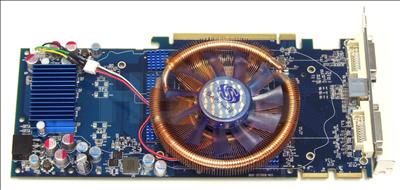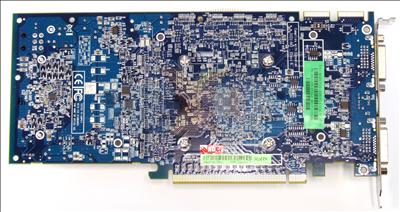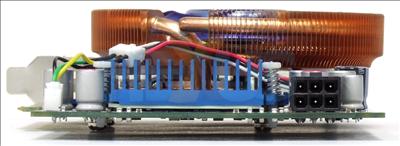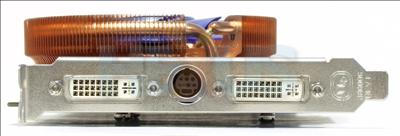The tour continues
Looking at it from the other side, eight RAMsinks can just about be viewed, running in an L-shaped fashion. The Radeon HD 4850 uses a 256-bit connection to the frame-buffer that's composed of eight 32-bit channels, which each module feeds into. Knowing that, all modules are located on the topside.
This card ships with the standard 512MiB frame-buffer for loading and storing data, although another model in the range - non-TOXIC this time - caters for a 1GiB frame-buffer, but runs at the base (reference) 625MHz/1,986MHz frequencies.
Specifically, the combination of aftermarket cooler and attention paid to memory cooling is manifested with clockspeeds of 675MHz for the core and shaders, and 2,200MHz for the GDDR3 memory, compared with 625MHz/625MHz/1,986MHz for the reference HD 4850 512 card. Easy math tells us that the TOXIC model has an eight per cent core/shader and 10 per cent memory advantage over the default card, and that should be borne out by the results in our benchmarks.
The overclocked figures are still a far cry from default Radeon HD 4870 speeds, though, which uses the same underlying architecture but ships with 750MHz/750MHz/3,600MHz (GDDR5) frequencies.
Et voila, nothing of real note to speak of on the back. Note the two CrossFire fingers on the back? Space-permitting, the card can be coupled with up-to three others for multi-GPU rendering under CrossFireX.
A front-facing shot reminds us that the ZALMAN cooler makes the card a two-slot-taking affair, up from the single-slot cooler on, you guessed it, the reference card. We can't see this being a problem for the intended market, whose main chassis is at least midi-tower-sized.
The hot-running power-regulation components also receive a heatsink makeover, too.
There's nothing untoward to report on the back. Both DVI ports take advantage of the HDMI pass-through - 7.1-channel for the HD 48x0 - capability of the GPU. In effect, if motherboard audio is routed to the graphics card via Vista's UAA feature, an HDMI converter, connected to the DVI port, can be used to ferry both audio and video to external displays.













